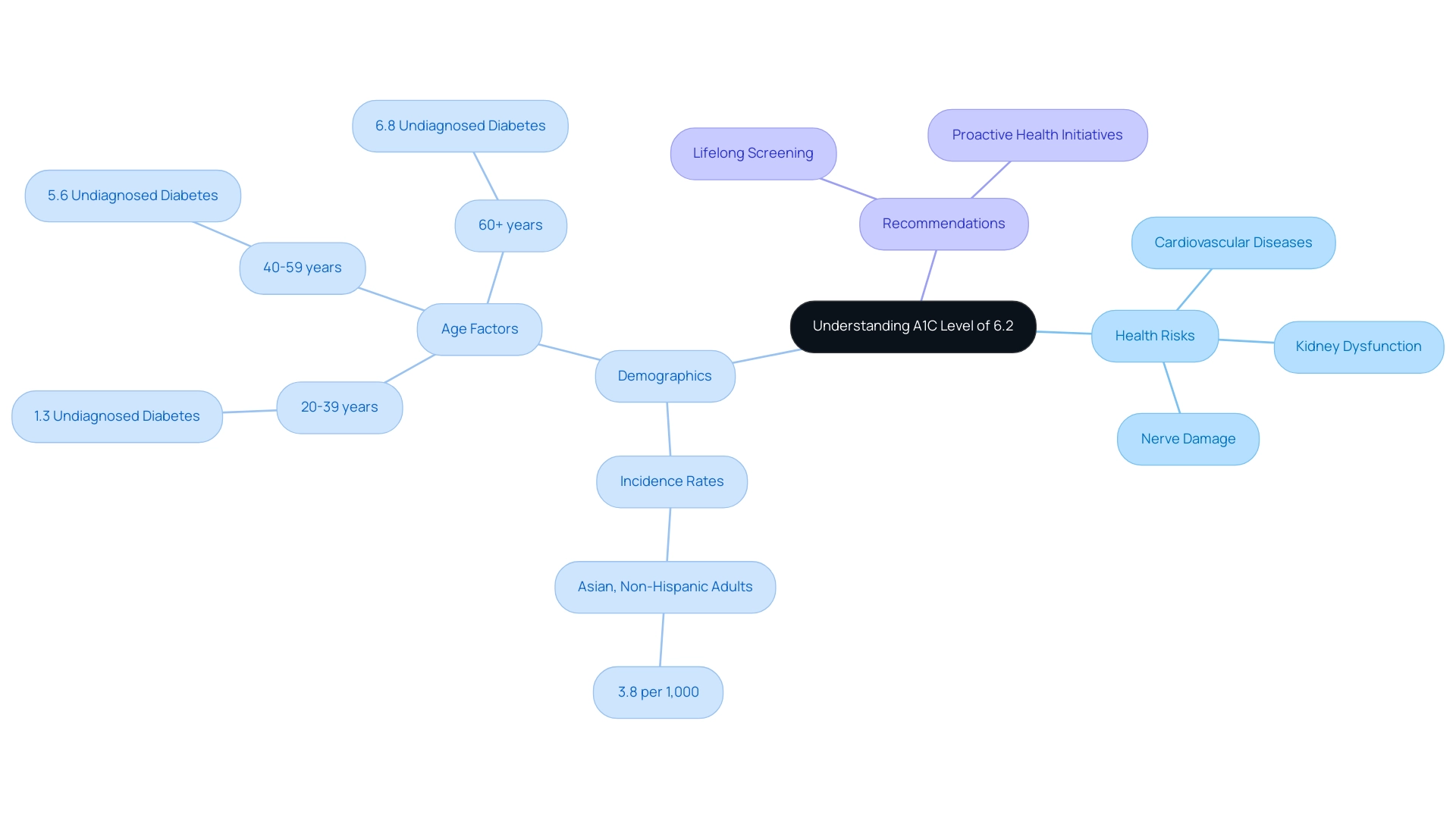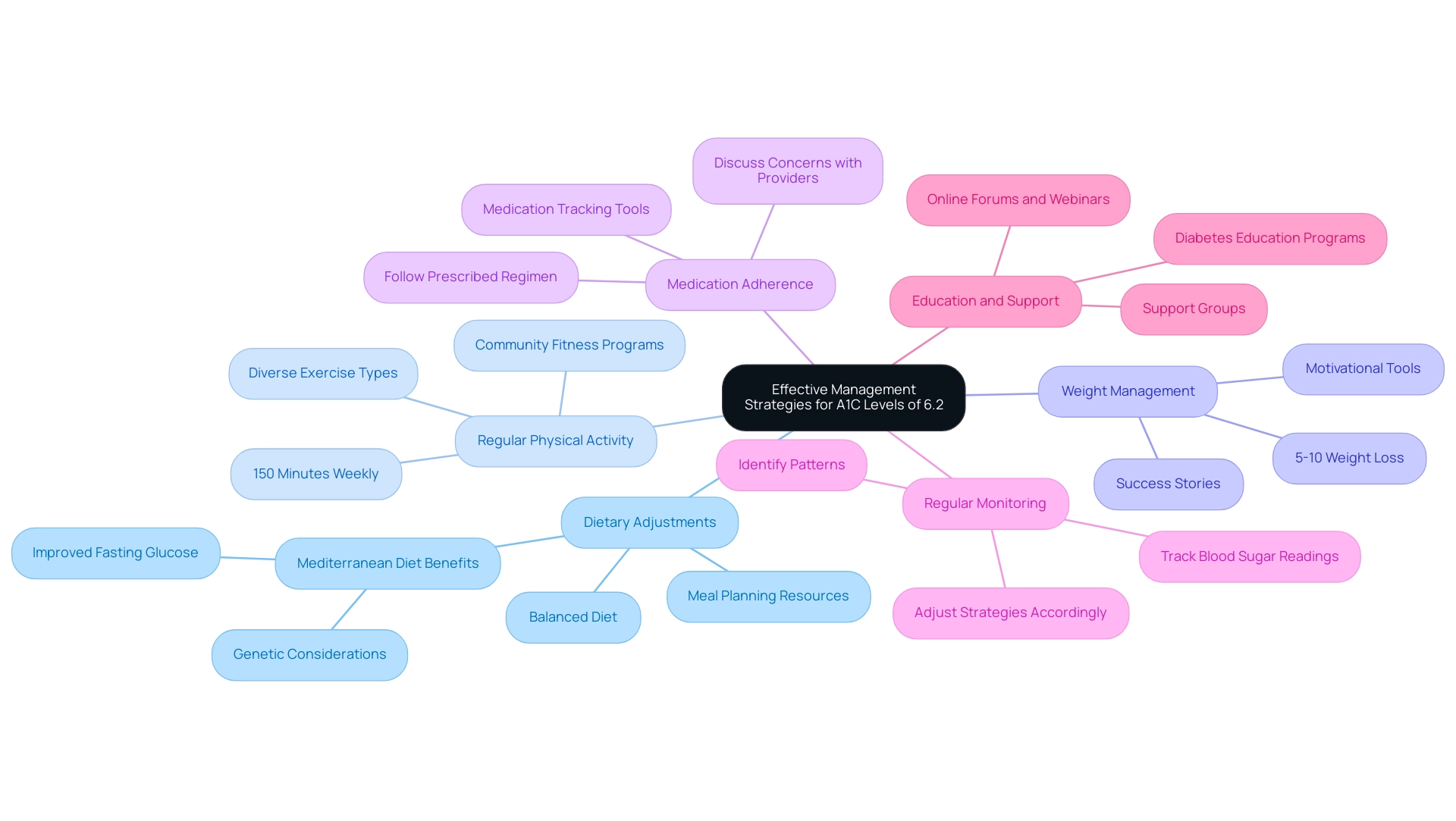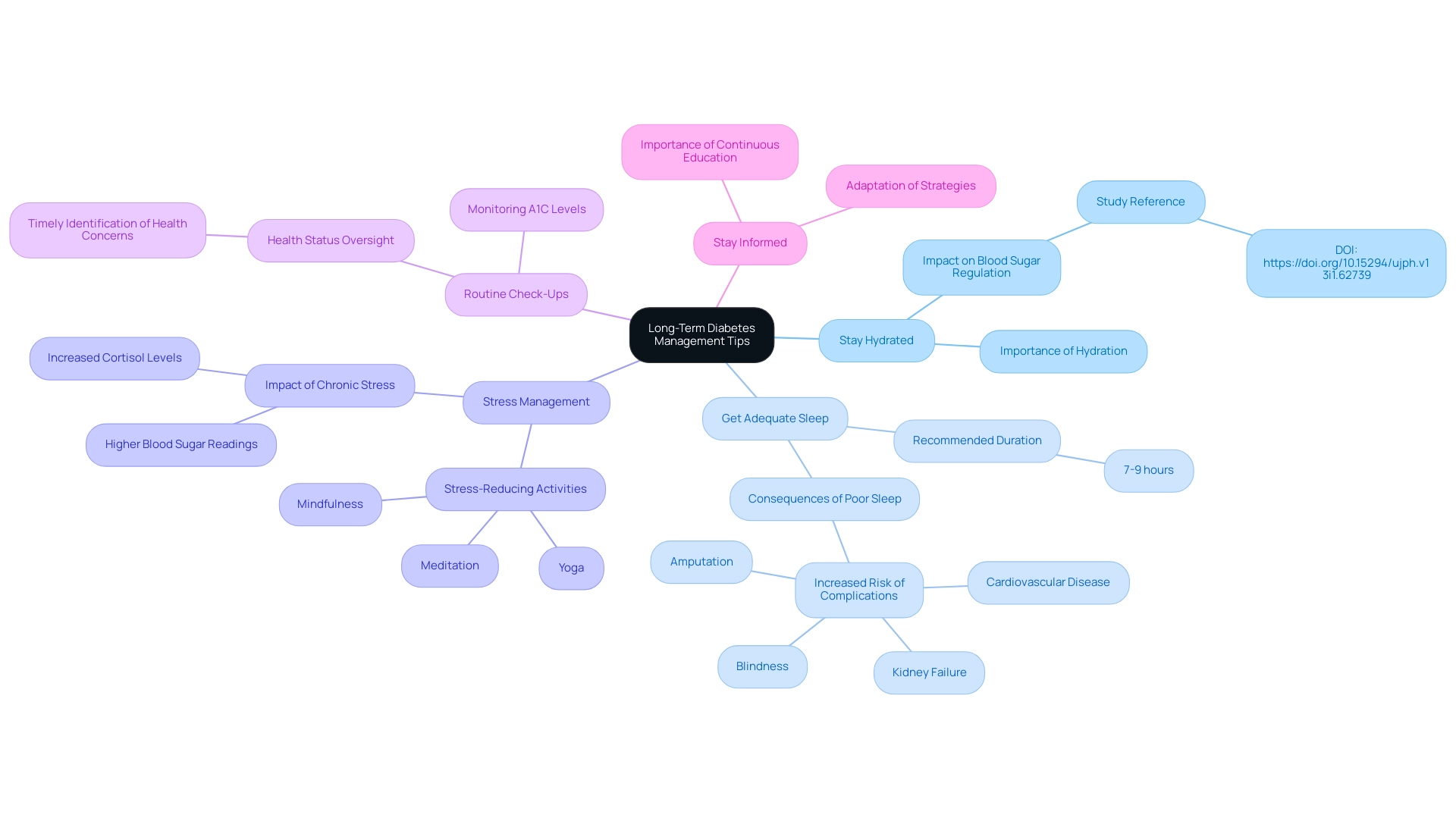Overview:
An A1C level of 6.2% indicates prediabetes and raises concerns about potential health complications such as cardiovascular diseases and kidney dysfunction. The article outlines effective management strategies, including dietary adjustments, regular physical activity, and weight management, emphasizing the importance of proactive health measures to mitigate the risks associated with this A1C level.
Introduction
Navigating the complexities of diabetes management begins with understanding critical health metrics, such as A1C levels. An A1C level of 6.2% serves as a pivotal indicator, suggesting that an individual is on the cusp of prediabetes and may be at an increased risk for serious health complications, including cardiovascular issues and kidney dysfunction.
As diabetes continues to rise in prevalence, particularly among older adults, the urgency for proactive management and education becomes paramount. T2DSolutions emerges as a vital resource, offering comprehensive support and information tailored to individuals facing these challenges.
This article delves into effective strategies for managing A1C levels, emphasizing the importance of:
- Lifestyle modifications
- Medication adherence
- Community engagement
in fostering long-term health and well-being.
Understanding the Implications of an A1C Level of 6.2%
Understanding an A1C 6.2 is crucial for newly diagnosed patients as they begin their health journey. This stage indicates that a person's average blood glucose readings over the prior two to three months fall within the prediabetes range, signaling not only the potential for future onset of the condition but also raising concerns about various health complications. Research shows that individuals with A1C levels of 6.2 or between 5.7% and 6.4% are at increased risk for cardiovascular diseases, kidney dysfunction, and nerve damage.
With T2DSolutions launching as a new resource hub dedicated to Type 2 and Type 3 health education and community support, we aim to empower patients with knowledge about these implications. As we prepare to launch, you can subscribe to stay updated and receive emails when new content is published. The urgency of understanding these risks is emphasized by the fact that the incidence rate of diagnosed diabetes-related conditions among Asian, non-Hispanic adults is 3.8 per 1,000, highlighting the need for timely screening and intervention.
Lifelong screening for prediabetes and type 2 disorders is particularly critical for individuals previously diagnosed with gestational diabetes mellitus (GDM). Endocrinologists promote proactive approaches to reduce these risks, particularly considering the growing occurrence of undiagnosed conditions related to blood sugar, which increases with age—from 1.3% in individuals aged 20–39 to 6.8% for those aged 60 and older. This demographic shift reinforces the need for targeted health initiatives similar to those backed by the organization.
As Samuel D. Towne Jr. pointed out, 'This research was backed by a grant from Blue Cross and Blue Shield of Texas to create the Texas A&M University Health Science Center Rural Health Moonshot Initiative,' highlighting the significance of comprehending A1C 6.2 values for effective control of blood sugar. Don't miss the chance to connect with our team as we offer valuable resources and assistance for your health management journey.

Effective Management Strategies for A1C Levels of 6.2%
To effectively manage an A1C measurement of 6.2%, individuals should consider implementing the following strategies while taking advantage of the resources provided by T2DSolutions, a new hub for Type 2 and Type 3 blood sugar education and community support:
-
Dietary Adjustments: Prioritize a balanced diet that includes whole grains, lean proteins, and healthy fats while significantly reducing processed sugars and refined carbohydrates. Including fiber-rich foods is essential, as they can help in regulating blood sugar. The PREDIMED study highlights that individuals adhering to the Mediterranean diet experienced improved fasting glucose readings, especially among those with genetic variants at the TCF7L2 gene, emphasizing diet's role in managing type 2 diabetes (T2D). This study supports that high adherence to the Mediterranean diet can attenuate genetic effects on fasting glucose, illustrating the importance of tailored dietary recommendations. T2DSolutions offers meal planning resources and recipes that align with these dietary guidelines, helping individuals make informed food choices.
-
Regular Physical Activity: Strive for at least 150 minutes of moderate-intensity exercise weekly, such as brisk walking or cycling. Regular physical activity enhances insulin sensitivity and promotes lower blood glucose levels. Recent guidelines suggest including diverse types of exercise to maximize advantages for blood sugar regulation, further reinforcing the connection between fitness and management of the condition. In fact, a significant change from baseline for homeostasis model assessment of insulin resistance was observed at –2.0 at 3 months, highlighting the effectiveness of these lifestyle changes. The organization offers access to community fitness programs and virtual classes that encourage active participation.
-
Weight Management: Achieving and maintaining a healthy weight is vital. A modest weight loss of 5-10% of body weight can lead to significant improvements in A1C 6.2 levels and a reduced risk of developing diabetes. Success stories from individuals who have effectively managed their weight through lifestyle changes further validate this approach. The platform showcases success narratives and encouraging tools that motivate people on their weight control journeys.
-
Medication Adherence: For those prescribed medications to control blood sugar, adherence to the prescribed regimen is essential. Engaging in open discussions with healthcare providers about any medication concerns ensures optimal management and reinforces the importance of following treatment plans. T2DSolutions encourages users to keep track of their medications and offers tools for managing prescriptions effectively.
-
Regular Monitoring: Consistent tracking of blood sugar readings, as recommended by healthcare professionals, is key. This practice aids in identifying patterns and making necessary adjustments to dietary or medication strategies, ultimately leading to better management outcomes. T2DSolutions provides resources for tracking blood sugar levels and understanding the implications of the readings.
-
Education and Support: Actively participating in diabetes education programs or support groups can provide invaluable guidance and encouragement. Interacting with others encountering similar challenges boosts motivation and provides varied perspectives on effective approaches. As J.J., the guarantor of a recent study, emphasizes, 'having access to comprehensive data and support networks is critical in ensuring the integrity of management efforts and promoting successful outcomes.' This underscores the importance of education and support in managing A1C levels effectively, particularly in achieving an A1C 6.2. The organization hosts online forums and educational webinars that connect individuals with experts and peers, fostering a supportive community. For additional resources and community assistance, visit the website to remain informed and engaged.

Additional Tips for Long-Term Management
Welcome to our new resource center devoted to enhancing health control through education and community assistance. As we launch, we invite you to subscribe for updates and stay informed about the latest insights and resources. In addition to primary management strategies, the following tips can support long-term success in diabetes management, and T2DSolutions is here to offer comprehensive resources and community support to empower you in your journey:
- Stay Hydrated: Adequate hydration is crucial for maintaining optimal blood sugar levels and can help regulate A1C levels. Drinking sufficient water can prevent dehydration, which may adversely affect glucose control. Recent studies have indicated a direct relationship between proper hydration and improved blood sugar regulation. According to the study available at https://doi.org/10.15294/ujph.v13i1.62739, staying hydrated plays a significant role in managing blood sugar effectively.
- Get Adequate Sleep: Aim for 7-9 hours of quality sleep each night. Ghulam Mustafa, an Associate Professor in the Department of Community Medicine, emphasizes that this condition is a significant factor leading to kidney failure, cardiovascular disease (CVD), blindness, and occasionally amputation. Poor sleep quality can worsen these risks by negatively affecting blood sugar management and resulting in an A1C 6.2, making restorative sleep essential. Just as 15% of parents are aware of thalassemia and its complications, understanding the implications of sleep on diabetes is equally important for effective management.
- Stress Management: Engaging in stress-reducing activities such as mindfulness, yoga, or meditation can help mitigate the impact of stress on blood glucose. Chronic stress is recognized to raise cortisol amounts, which can result in heightened blood sugar readings.
- Routine Check-Ups: Regular appointments with healthcare providers are vital for monitoring A1C levels, including achieving an A1C 6.2, kidney function, and overall health status. Timely identification of possible health concerns greatly improves efficient oversight and lowers complications linked to blood sugar disorders. For instance, the research named "VKORC1 Gene Polymorphism in Warfarin Therapy Patients" demonstrates how genetic elements can affect health approaches, which may be pertinent to blood sugar treatment as well.
- Stay Informed: Keeping abreast of the latest research and administration techniques in diabetes care is imperative. Continuous education enables patients to adapt their strategies based on new findings, ultimately improving their quality of life and management outcomes. As T2DSolutions launches, we aim to be your go-to resource for up-to-date information and community support.

Conclusion
Understanding A1C levels, particularly at the threshold of 6.2%, is critical for effective diabetes management. This level serves as a warning sign, indicating a potential progression towards prediabetes and associated health risks such as cardiovascular disease and kidney dysfunction. Implementing lifestyle modifications, adhering to medication regimens, and actively engaging with community resources are essential strategies for managing A1C levels and improving overall health outcomes.
By prioritizing dietary adjustments, regular physical activity, and weight management, individuals can significantly influence their A1C levels. Additionally, consistent monitoring and education play vital roles in empowering individuals on their diabetes management journeys. T2DSolutions stands out as a valuable resource, providing a wealth of information and community support to help navigate these challenges effectively.
In conclusion, taking proactive steps towards understanding and managing A1C levels can lead to healthier outcomes and a better quality of life. With the right tools, resources, and support, individuals can not only manage their diabetes but also thrive in their health journeys. Engaging with T2DSolutions and utilizing its offerings can be a transformative step towards achieving long-term health and well-being.



